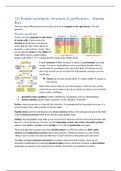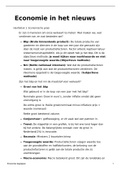12) Protein synthesis, structure & purification – Stanley
Brul
There are many different proteins and they need to be targeted to the right places in the cell
(specific).
Protein structure:
Protein structure depends on side chains
of amino acids. It determines the
function of the protein. You need to
know what the side chains represent
(negative = acid, positive = basic). They
are encoded by triplets in the mRNA (29
single tRNAs and 16 wobble tRNAs).
Always read codes 5’ 3’. Coding strand is equal to the mRNA strand.
5’ to 3’ synthesis of DNA necessary to allow for proofreading, you need
energy. You have a triphosphate on the incoming nucleotide which is
used to link the nucleotide to the rest of the DNA. If synthesis was the
other way around you do not have the triphosphate coming in, process
would stop.
Viruses do not have proofreading mutate rapidly escape us
and survive.
Most of the amino acids we can make ourselves. There are also amino
acids that we cannot make at all and are strictly essential or just essential
under certain conditions.
Essential certain conditions: Valine, Methionine, Tryptophan, Leucine, Phenylalanine,
Strictly essential (cannot make ourselves): Lysine, Histidine, Threonine
Proline: Amino group forms a ring with the sidechain consequences for the protein structure, it is
a helix breaker and is often present at domain edges.
Peptide bond: Bond formed between the amino terminus (NH2) of the aminoacid bound to the tRNA
and the carboxy terminus (COO) of the already made peptide chain.
Folding: The polypeptide chain folds as it grows from the ribosome, first the N terminal domain folds,
then the C terminal domain. Proteins can fold depending on their side chains. Non-polar proteins
will be in the centre and polar on the outside so it can form hydrobonds with water.
The human genome contains more than 20.000 proteins (as ORFs) but there are SNPS, splice
variants and combinatorial variants with varying domains. Different proteins can have similar
“things” such as active sites because they have similar function or interaction with each other.
The inter and intra molecular interactions in proteins determine their folding. There can be
secondary modifications for example phosphorylation (serine, threonine, tyrosine) or glycosylation
(asparagine & arginine). They determine the activity, localisation and stability of proteins.
,In the lab folding can be reversed with urea. When you
remove the urea the original conformation of the protein
re-forms (in correct folding conditions). When you denature
the protein will never go back to the original confirm.
Commonly occurring protein folds:
Alfa helix structure: You have hydrophobic domains on the one side of the protein and
hydrophilic on the other side. This is useful for membranes.
Beta sheet structure: Very long flexible sheets, it is really stable and big. You have it in actin
like structures (cytoskeleton) like neurons. It can be parallel or antiparallel. Depending on the
side chains they associate.
Proteins get structural flexibility (like actin) through the presence of sulphur bridges. In cysteine
there can be an intrachain disulphide bond (on SH group). Whether it forms a bridge depends on the
redox state of the surroundings.
Protein folding is energy dependent and highly
controlled in the cell, heat shock proteins (hsp70)
use ATP to prevent untimely folding. It keeps it in
an unfolded state until the conditions are right
(redox, place etc) and then it can fold.
, Incorrectly folded proteins can be corrected but this costs energy. Hsp60-like GroES chaperone can
assist with folding, it has hydrophobic binding pockets.
Misfolded proteins are degraded in the proteasome to avoid aggregate formation. Proteasome has
active sites where it degrades protein with the polyubiquitin chain (signal!). Ubiquitination
consumes ATP and thus waste management
costs energy. Ubiquitin activating enzymes can
see that hydrophobic domains are being
exposed incorrectly folded protein
enzymes are activated and put ubiquitin on
lysine 48 (K48) of the wrongly folded protein
(by ubiquitin ligase).
Protein synthesis can be specifically inhibited with antibiotics. Some antibiotics bind to the
ribosome (A, P and E site) and thereby inhibit the function of the ribosome (same site as where
tRNAs would bind). Antibiotics have side effects on mitochondria because these were bacteria.
Since mitochondria have their own translation apparatus, side effects can happen here.
Enzyme activity & inhibition
Michaelis Menten: Affinity means that you can catalyse the reaction. If you have high affinity the
reaction goes very fast. Internal energy of products is lower than substrates. It is depended on
nature and concentration of reactants.
Nature is the thermodynamical energy in
bonds. If you burn it, the amount of heat
that comes free internal energy.
Concentration: If you have more of a
substrate you can drive the reaction to
one side.
At equilibrium: You do not have any
change in free energy of product and
substrate. DeltaG is zero.
Enzyme binds the
substrate, this lowers the activation energy and the reaction can
happen more easily than uncatalyzed reactions. Enzyme has to have a
high affinity for substrate and a low affinity for the product to let it go.
Delta G is not influenced by enzyme, the enzyme just facilitates the
reaction.
Hydrogen bonds and ion interactions stabilize active site binding.
Hydrogen bond rearrangements mediated by histidine, serine and
aspartate can occur to activate the OH group of serine so it is reactive
to double bonds or positively charged molecules.
Sometimes enzymes need help by co-factors
such as haemoglobin or vitamin A (for
rhodopsin).
Michaelis Menten kinetics: Rate of enzyme reaction (V) against substrate concentration [S].






